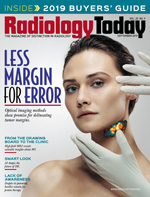 CT Slice: Properly Vetted
CT Slice: Properly Vetted
By Brett Adams
Radiology Today
Vol. 20 No. 9 P. 6
When oversized zoo dwellers are in need, portable scanners are delivering big.
Layla and Gigi were both feeling under the weather. Layla is an 8 1/2-year-old, critically endangered black rhinoceros living at Brookfield Zoo, just outside of Chicago. Gigi is a 47-year-old Western Lowland gorilla living at Franklin Park Zoo in Boston. Although a thousand miles separate them, they will always be connected by their medical care.
Layla, weighing in at more than 2,300 lbs, was suffering from an obstruction in her nasal passageway. As obligate nasal breathers, it is very difficult for rhinos to breathe through the mouths for long periods of time. Therefore, nasal obstructions can become life threatening. When standard treatments did not work, Layla had bilateral sinusotomy surgery in January 2018. During the surgery, veterinarians identified a bacterial infection in her nasal passageway and spent months anesthetizing her to provide IV antibiotics and remove infected tissue. Unfortunately, the source of the problem was elusive; it was determined that advanced imaging would be necessary.
Meanwhile, Gigi, one of the oldest living gorillas in North America, was taken off exhibit due to her own health issues. Her veterinary and animal care teams began noticing changes in her energy, mobility, and appetite and quickly diagnosed a urinary tract infection, resulting in further exams. From her bloodwork, the veterinary staff found elevated biliary enzymes and elevated kidney values. By themselves, the values are nonspecific as to a cause but have the potential to be symptoms of gall bladder and kidney failure. It was promptly determined that further testing, including advanced imaging and a liver biopsy, would be necessary.
Big Challenges
Layla and Gigi were in desperate need of CT scans to help their care teams more specifically diagnose and treat their varying conditions. However, the logistics of getting either animal into a CT scanner were more complicated than driving them to the local imaging center. In Layla’s case, Brookfield Zoo’s CT scanner is located in the zoo’s animal hospital, but Layla is too large to move within that space. For Gigi, taking her away from her home of 46 years to an offsite hospital for imaging was too complicated and could have resulted in further negative effects on her health. NeuroLogica’s BodyTom CT scanner provided the solution.
The BodyTom is the world’s first battery-powered, portable, 32-slice CT scanner. By bringing the state-of-the-art scanner to each location, Layla’s and Gigi’s teams were able to minimize the risk associated with transferring the ailing patients, while still obtaining the clear imaging needed to proceed with treatment.
Since animals are not very good at following directions such as “lie still,” great care had to be taken during the scans, especially given the fact that both animals were administered general anesthesia, which comes with great risk to the animal and caregivers.
For Layla, a custom-made platform had to be built. After being anesthetized and stabilized, Layla was placed on the platform. A front-end loader gently moved the platform to the zoo’s surgical table, and then the table was moved to the portable CT scanner. In Gigi’s case, it was not necessary to use the heavy equipment for transportation, but it was still important to ensure Gigi was comfortable and safe. If a large and potentially dangerous animal such as Layla or Gigi were to awaken from anesthesia, she could be agitated and confused, and the possibility of harm to herself and/or the attending staff increases greatly. In both cases, it took detailed preparation and time from zoo staff and technicians from NeuroLogica to make sure Layla and Gigi had successful and safe scans. And the results were exactly what both teams were looking for.
A Clear Way Forward
According to Michael Adkesson, DVM, vice president of clinical medicine for the Chicago Zoological Society, who has worked closely with Layla’s team, “The CT scan allowed us to identify an unerupted molar tooth at the center of a proliferative mass. The mass was extending into the sinus and nasal passages, where it was obstructing airflow. A complete obstruction of nasal airflow can quickly progress to a fatal condition.”
What followed were dozens of procedures—including a second CT scan—and surgeries to treat the blockage, some of which are believed to be the first of their kind on a black rhino. When Layla celebrated her eighth birthday in October 2018, she was on her way to recovery, breathing comfortably from both nostrils, thanks to stents placed in her nasal passageways.
Gigi, however, continues to have several underlying health issues. Eric Baitchman, DVM, Zoo New England’s vice president of animal health and conservation, says, “The CT scan revealed that Gigi has tumors in her liver and uterus, bilateral chronic degenerative change in the kidneys, and bilateral hydroureter.” He adds, “The scan was critical for our ability to make these diagnoses and direct targeted treatment.” One of the treatments included a ureteral stent in order to relieve a partial obstruction of urine flow. There has also been some success with medications to address discomfort. But, most importantly, her appetite and activity have improved and the staff continues to take great care of Gigi.
A considerable distance may separate Layla and Gigi, but their lives have both been improved and perhaps saved by teams of doctors and technicians willing to volunteer their expertise and time. Considering there is now a portable CT scanner that has the capability to provide diagnostic imaging in a broader range of settings, perhaps our more vulnerable populations will have greater access to life-saving services.
— Brett Adams is a freelance writer based in Pittsburgh.

